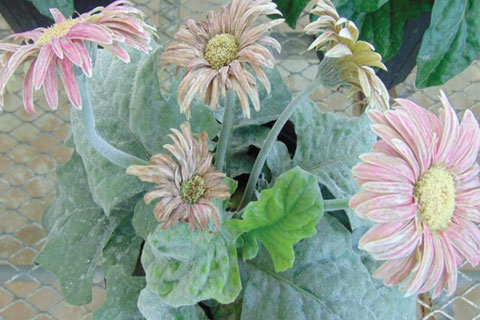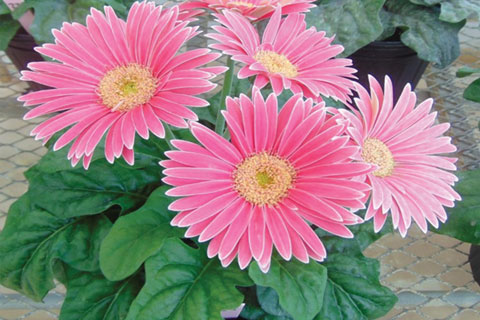3/1/2022
Decreasing the Risk
Carson Cashwell

Spring is one of the busiest times of the year because of the large variety of bedding plants produced, which can present ornamental growers with unique challenges. Chief among them is ensuring proper disease control and plant health. The warmer temperatures and transportation from greenhouses and nurseries at the end of production place crops at an increased risk of disease development. As production continues, consider the following strategies:
• Employ proven cultural practices, like maintaining a clean growing environment and properly managing irrigation timing, to help prevent the onset of disease.
• Recognize the early signs of disease by scouting early and often to quickly identify problems and remove infected plants.
• Develop a disease management program that includes a rotation of effective fungicide products, including Postiva fungicide.
Cultural tips to combat spring diseases
Implementing proper cultural practices is the first step to ensure healthy crops throughout production. Many of the common diseases encountered in the spring originate due to environmental conditions that are favorable to disease development. That’s why the first practice in any operation is to provide a clean, dry growing environment and to keep humidity low by heating or venting.
“Additionally, as a standard practice before crops are shipped, I encourage growers to scout one final time for symptoms of disease and immediately remove wounded and diseased plants, as well as dead flowers and leaves to limit spore production and spread,” said Nancy Rechcigl, technical services manager for ornamentals at Syngenta.
Scouting
Closely monitoring for diseases from propagation to shipping is necessary to maintain the health of crops as they make their way to customers.
Some of the primary bedding plants grown in spring—including daisies, geraniums and pansies—are susceptible to a variety of diseases. Spotting symptoms early on will help determine the best actions to prevent the spread of diseases and ensure high-quality crops. Common diseases encountered during spring production include:
• Botrytis, or gray mold, is caused by the fungus Botrytis cinerea. It’s the most common disease that affects ornamental plants and thrives in cool, humid environments. It’s especially threatening in spring, as plants are being prepared for storage and shipping. Humidity and ethylene levels are elevated during this stage of production and during transit, which contributes to plant stress and susceptibility.
Botrytis infections can develop overnight under the right conditions, so it’s important to scout regularly. Once the disease is established, gray mold can quickly spread through the crop and production area. Initial signs of Botrytis include small, water-soaked spots on foliage and flowers. When scouting for Botrytis, be sure to look out for symptoms such as small, light brown spots or tiny flecks on flowers and V-shaped, tan-brown lesions on foliage. While all ornamental crops are susceptible to Botrytis, crops in the post-harvest stage should be scouted prior to shipping.
• Recognizing the early signs of downy mildew is essential to mitigating its damage to plants. Be on the lookout for leaf discoloration or blotching, often within the veins, which are the most common initial symptoms. Stunting, leaf distortion and mortality can occur when the fungus invades the plant internally. Pansies, impatiens and roses are just a few of the crops susceptible to downy mildew. Downy mildew pathogens prefer moderate to cool temperatures and high-humidity conditions. Carefully inspect plants for pale foliage with yellow, tan or reddish blotchy areas and look at the undersides of the foliage for signs of sporulation. This will appear as white or light gray/purple fuzz on the underside of affected foliage. Make sure shipping conditions are dry because only a thin layer of moisture is needed for disease development. A rotation using Subdue Maxx, Micora and Segovis fungicides will keep plants healthy and ready for shipping.
• Look for leaf spot diseases in the later spring months as warmer temperatures, coupled with rainfall and nightly dew, provide the perfect conditions for fungal spore germination. While leaf spots aren’t a serious threat to plant health, they can negatively affect the overall appearance of your crop.
Leaf spots can be caused by many different fungal pathogens, including Alternaria spp., Cercospora spp. and Colletotrichum spp., as well as bacterial pathogens such as Xanthomonas and Pseudomonas spp. Start inspecting the lower and interior canopy of plants for spots, as they may initially develop there due to wet foliage, reduced air movement and higher relative humidity. Fungal leaf spots tend to be more rounded in appearance with distinct margins and a colored border. Bacterial leaf spots initially appear as water-soaked spots that are more angular in shape. This tissue will eventually turn dark and have a greasy appearance. Both fungal and bacterial leaf spots can have yellow borders around the lesion.
• Many bedding plants and perennials are susceptible to powdery mildew pathogens. This disease first appears as white, talcum-like spots called “colonies” on leaves, stems and flowers. The colonies grow in size and number to cover the plant’s surface and can cause leaves to turn yellow, brown and then drop if uncontrolled.
Being prepared for potential diseases that may impact operations can help avoid damage to crops and ensure high plant quality through the end of the season. However, cultural practices and scouting alone are sometimes not enough to control diseases. Get ahead of diseases with proven disease control solutions from Syngenta.


Perfecting disease management programs with Postiva
Now available from Syngenta, ornamental growers can incorporate Postiva fungicide into their disease management programs to combat foliar and soilborne diseases on their ornamentals. Postiva provides broad-spectrum, long-lasting control of various diseases that are common in the spring like Botrytis, powdery mildew and leaf spots among manyothers, including bacterial diseasesuppression.
Available for ornamental crops, listed vegetable plants1, and non-bearing fruit and nut plants in greenhouses, nurseries, and residential and commercial landscapes, Postiva is powered by ADEPIDYN technology, a succinate dehydrogenase inhibitor (SDHI) in FRAC group 7, and difenoconazole, a DMI (demethylation inhibitor) fungicide in FRAC group 3. With two modes of action, Postiva offers a strong defense against multiple pathogens, including bacterial disease suppression, while helping delay the development of resistance when used in rotation with other trusted Syngenta products, such as Mural, Palladium or Daconil brand fungicides.
Pictured: Control of powdery mildew on Gerbera daisy. Inoculated control (top) and Postiva 10 fl. oz. (bottom). Photo credit: Krasnow, Vero Beach Research Center, Syngenta (2018).
“Postiva is a very convenient addition to any grower’s program. It can be applied as a foliar spray or soil drench through various types of spray equipment commonly used for making ground and aerial treatments, including chemigation or through auto cold fogging systems,” said Nancy. “Plus, once applied, Postiva quickly moves from the leaf surface into the waxy layer, which creates a reliable, rainfast barrier of protection.”
Unexpected challenges can arrive at any stage of ornamental crop production. Finish strong by incorporating Postiva fungicide for long-lasting protection and reliable control of difficult diseases. GT
For more information about Postiva, visit GreenCastOnline.com/Postiva or download any of our proven agronomic programs from GreenCastOnline.com/Solutions to learn how to best incorporate Postiva into your management program.
Carson Cashwell is the Ornamental Market Manager for Syngenta.